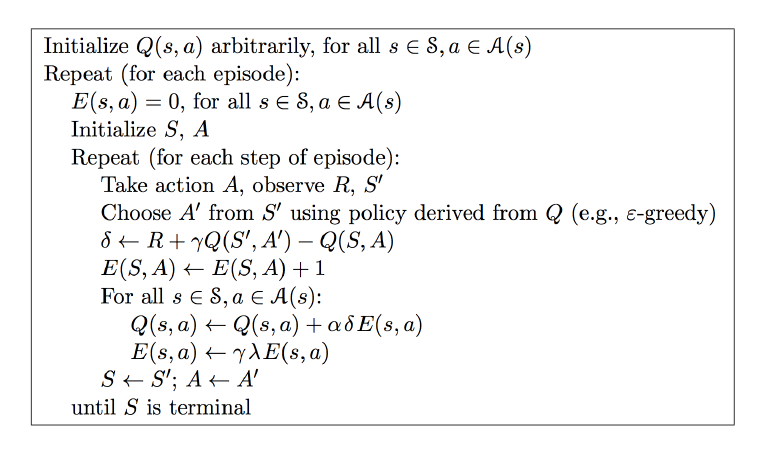本文作者:hhh5460
本文地址:https://www.cnblogs.com/hhh5460/p/10147265.html
将例一用saras lambda算法重新撸了一遍,没有参照任何其他人的代码。仅仅根据伪代码,就撸出来了。感觉已真正理解了saras lambda算法。记录如下
0. saras lambda算法伪代码

图片来源:https://morvanzhou.github.io/static/results/reinforcement-learning/3-3-1.png(莫凡)
1. saras lambda算法真实代码
# e_table是q_table的拷贝
e_table = q_table.copy()
# ...
# saras(lambda)算法
# 参见:https://morvanzhou.github.io/static/results/reinforcement-learning/3-3-1.png
for i in range(13):
# 0. e_table清零
e_table *= 0
# 1.从状态0开始
current_state = 0
# 2.选择一个合法的动作
current_action = choose_action(current_state, epsilon)
# 3.进入循环,探索学习
while current_state != states[-1]:
# 4.取下一状态
next_state = get_next_state(current_state, current_action)
# 5.取下一奖励
next_reward = rewards[next_state]
# 6.取下一动作
next_action = choose_action(next_state, epsilon)
# 7.计算德塔
delta = next_reward + gamma * q_table.ix[next_state, next_action] - q_table.ix[current_state, current_action]
# 8.当前状态、动作对应的e_table的值加1
#e_table.ix[current_state, current_action] += 1 # 这是标准的操作,但是莫凡指出改成下面两句效果更好!
e_table.ix[current_state] *= 0
e_table.ix[current_state, current_action] = 1
# 9.遍历每一个状态的所有动作(不能仅合法动作)
for state in states:
for action in actions:
# 10.逐个更新q_talbe, e_table中对应的值
q_table.ix[state, action] += alpha * delta * e_table.ix[state, action]
e_table.ix[state, action] *= gamma * lambda_
# 11.进入下一状态、动作
current_state, current_action = next_state, next_action第9步,刚开始我这么写:for action in get_valid_actions(state):,运行后发现没有这样写好:for action in actions:
2. 完整代码
'''
-o---T
# T 就是宝藏的位置, o 是探索者的位置
'''
# 作者: hhh5460
# 时间:20181220
'''saras(lambda)算法实现'''
import pandas as pd
import random
import time
epsilon = 0.9 # 贪婪度 greedy
alpha = 0.1 # 学习率
gamma = 0.8 # 奖励递减值
lambda_ = 0.9 # 衰减值
states = range(6) # 状态集。从0到5
actions = ['left', 'right'] # 动作集。也可添加动作'none',表示停留
rewards = [0,0,0,0,0,1] # 奖励集。只有最后的宝藏所在位置才有奖励1,其他皆为0
q_table = pd.DataFrame(data=[[0 for _ in actions] for _ in states],
index=states, columns=actions)
e_table = q_table.copy()
def update_env(state):
'''更新环境,并打印'''
env = list('-----T') # 环境
env[state] = 'o' # 更新环境
print('\r{}'.format(''.join(env)), end='')
time.sleep(0.1)
def get_next_state(state, action):
'''对状态执行动作后,得到下一状态'''
global states
# l,r,n = -1,+1,0
if action == 'right' and state != states[-1]: # 除末状态(位置),向右+1
next_state = state + 1
elif action == 'left' and state != states[0]: # 除首状态(位置),向左-1
next_state = state -1
else:
next_state = state
return next_state
def get_valid_actions(state):
'''取当前状态下的合法动作集合,与reward无关!'''
global actions # ['left', 'right']
valid_actions = set(actions)
if state == states[0]: # 首状态(位置),则 不能向左
valid_actions -= set(['left'])
if state == states[-1]: # 末状态(位置),则 不能向右
valid_actions -= set(['right'])
return list(valid_actions)
def choose_action(state, epsilon_=0.9):
'''选择动作,根据状态'''
if random.uniform(0,1) > epsilon_: # 探索
action = random.choice(get_valid_actions(state))
else: # 利用(贪婪)
#current_action = q_table.ix[current_state].idxmax() # 这种写法是有问题的!
s = q_table.ix[state].filter(items=get_valid_actions(state))
action = random.choice(s[s==s.max()].index) # 可能多个最大值,当然,一个更好
return action
# saras(lambda)算法
# 参见:https://morvanzhou.github.io/static/results/reinforcement-learning/3-3-1.png
for i in range(13):
e_table *= 0 # 清零
current_state = 0
current_action = choose_action(current_state, epsilon)
update_env(current_state) # 环境相关
total_steps = 0 # 环境相关
while current_state != states[-1]:
next_state = get_next_state(current_state, current_action)
next_reward = rewards[next_state]
next_action = choose_action(next_state, epsilon)
delta = next_reward + gamma * q_table.ix[next_state, next_action] - q_table.ix[current_state, current_action]
#e_table.ix[current_state, current_action] += 1 # 这是标准的操作,但是莫凡指出改成下面两句效果更好!
e_table.ix[current_state] *= 0
e_table.ix[current_state, current_action] = 1
for state in states:
for action in actions: #get_valid_actions(state):
q_table.ix[state, action] += alpha * delta * e_table.ix[state, action]
e_table.ix[state, action] *= gamma * lambda_
current_state, current_action = next_state, next_action
update_env(current_state) # 环境相关
total_steps += 1 # 环境相关
print('\rEpisode {}: total_steps = {}'.format(i, total_steps), end='') # 环境相关
time.sleep(2) # 环境相关
print('\r ', end='') # 环境相关
print('\nq_table:')
print(q_table)
来源:oschina
链接:https://my.oschina.net/u/4348545/blog/3706391